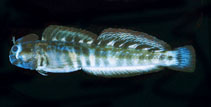| Family: |
Blenniidae (Combtooth blennies), subfamily: Salariinae |
| Max. size: |
7.9 cm SL (male/unsexed) |
| Environment: |
pelagic-neritic; marine |
| Distribution: |
Western Central Pacific. Eastern Central Pacific: Pitcairn (Ref. 41650) and French Polynesia (Ref. 46206). |
| Diagnosis: |
Dorsal spines (total): 13-13; Dorsal soft rays (total): 17-20; Anal spines: 2-2; Anal soft rays: 19-22. Lip margins smooth; females dorsally whitish to light gray and ventrally white with a series of 6 paired black spots (anterior 2 pairs irregular with a row of spots above) on upper side of body, and 1 spot on caudal peduncle, each connected by a gray bar to a lower series; a black line on back at spinous portion of dorsal fin, and 4 pairs of small black spots along base of soft portion; small bluish white spots on posterior half of body, mostly on upper half; narrow black bars ventrally on head angling on to throat; a white line at posterior edge of eye continuing below to upper lip; median fins with blackish margins; posterior part of crest with a narrow pink margin and a broad, submarginal black band; dorsal-fin base with alternating black and whitish blotches; a black spot at midbase of caudal fin; males similar except with darker body; bluish white spots on body generally elliptical; faint oblique black bands on throat; oblique white lines in soft portion of dorsal fin. Last spine of dorsal fin very small; dorsal soft rays usually 19; anal soft ray rarely 19 or 22; middle 6-9 of 14 segmented caudal rays branched; lateral-line pores 5-9 (Ref. 54980). |
| Biology: |
Adults are found in tidepools (Ref. 54980). Oviparous. Eggs are demersal and adhesive (Ref. 205), and are attached to the substrate via a filamentous, adhesive pad or pedestal (Ref. 94114). Larvae are planktonic, often found in shallow, coastal waters (Ref. 94114). |
| IUCN Red List Status: |
Least Concern (LC); Date assessed: 27 March 2009 Ref. (130435)
|
| Threat to humans: |
harmless |
| Country info: |
|
Source and more info: www.fishbase.org. For personal, classroom, and other internal use only. Not for publication.

